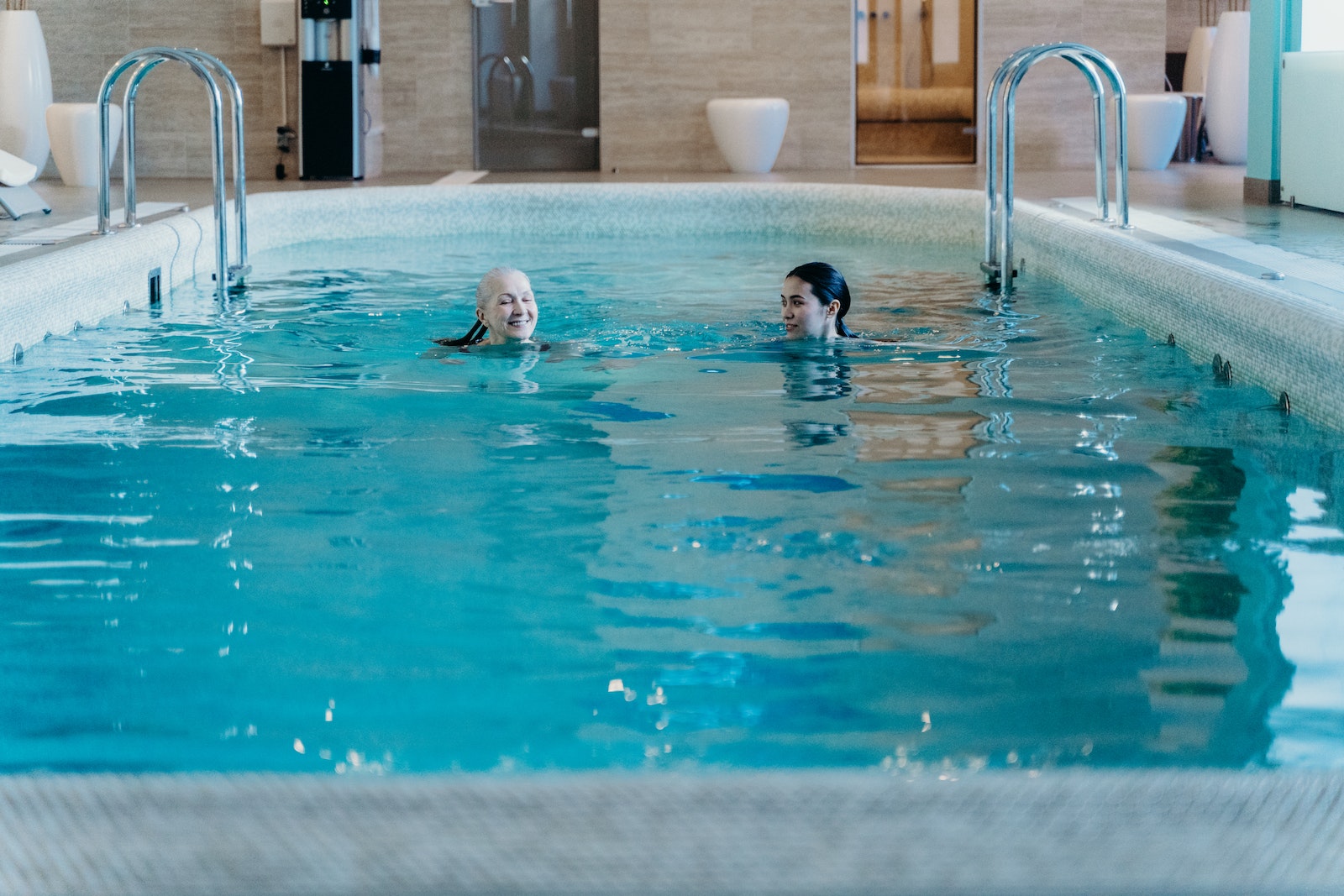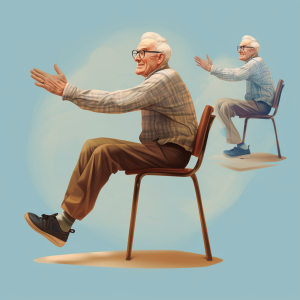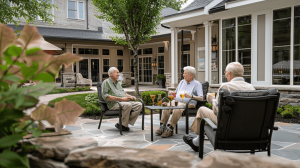Ah, the knees! Those magnificent joints that have supported us for decades become weary. But fret not! Knee exercises for seniors can be the melodic remedy to keep those knees groovy. As we age, especially in our golden years, they might start singing a different tune, perhaps one of discomfort or stiffness.In this rhythm of life, let’s tap into the best methods that ensure our knees remain strong, flexible, and pain-free.
Contents
Why Knee Health is Crucial for Seniors
Remember when you’d race against the wind, feeling the ground swiftly pass beneath your feet? Or those evenings when you’d sway and whirl on the dance floor, lost in the rhythm? It seems like yesterday, doesn’t it? Our knees were our unspoken heroes during those moments, supporting every leap, every twist, and every step. But as the pages of time turn, our faithful knees, like the rest of our body, undergo natural wear and tear.
So, why does this matter so much, especially for seniors?
Well, knees aren’t just joints; they’re the very foundation of our mobility. They act as the hinge that propels our movements, the shock absorbers when we walk, and the support system when we stand. Every time you get up from a chair, climb stairs, or even take a simple stroll in the park, it’s your knees that bear the weight, ensuring you move with ease.
Now, as we gracefully step into our senior years, these pivotal joints might start to show signs of fatigue, often manifesting as pain, stiffness, or reduced flexibility. But that doesn’t mean the music needs to stop or the dance has to end. On the contrary, it’s a sign to give them some TLC.
Aging and the accompanying changes are inevitable. Cartilage might thin out, ligaments might lose their elasticity, and sometimes, arthritis might join the party. But here’s the good news: with the right knee exercises and care, we can strengthen the muscles around the knees, improve flexibility, and reduce the impact of these age-related changes.
Think of it as tuning a musical instrument. Over time, a guitar might need its strings adjusted or a piano its keys tuned. Similarly, our knees, with a bit of care and the correct exercises, can continue to support us, allowing us to dance, walk, and move with the same vigor. Because no matter the age, every day can be a dance, and our knees can remain our steadfast partners. So, ready to give them the care they deserve?
Water Exercise – Swimming
Ah, the joy of jumping into a pool! But did you know that the same waters where you splash and unwind can also offer one of the best workouts? Water exercise, often overlooked, is a fantastic way to get fit without putting undue strain on your joints. Think of it as a gym where the equipment is replaced by resistance in every direction – courtesy of the water.
A Float Through The Benefits
- Gentle on the Joints: The buoyancy of water reduces the weight placed on joints, making it perfect for those with arthritis or knee problems. Remember the joy of feeling light as a feather in water? That’s your joints celebrating!
- Resistance Training: Moving against water isn’t as easy as it looks, right? Water offers natural resistance, making even simple movements an effective strength training exercise.
- Cardio Boost: Aqua aerobics or simply treading water can elevate your heart rate, offering a cardiovascular workout equivalent to a jog or brisk walk.
- Flexibility: With a wider range of motion underwater due to decreased gravity, you can improve flexibility more effectively than land-based exercises.
The Ripple Effect of Water Exercise Types
- Aqua Aerobics: Think Zumba but in water! An instructor guides through dance and movement routines. It’s fun, energetic, and can make you forget you’re even exercising.
- Lap Swimming: Good old-fashioned swimming. Alternate between different strokes to engage different muscle groups.
- Aqua Jogging: No, it’s not running late to a pool party. It’s jogging in place in the deeper end of a pool. The water’s resistance amplifies this otherwise simple activity.
Packing For Your First Splash
If you’re diving into water exercises, remember:
- Proper Swimwear: Invest in comfortable and snug-fitting swimwear. Nobody wants an unexpected wardrobe malfunction!
- Water Shoes: These can provide better traction on the pool floor, especially during aqua aerobics.
- Hydration: Just because you’re in water doesn’t mean you can’t get dehydrated. Always have a water bottle handy.
But What If I Can’t Swim?
A common misconception is that you need to be a swimmer to indulge in water exercises. Many routines, especially aqua aerobics, are designed for non-swimmers and are conducted in shallow waters.
Strengthening vs. Stretching
Imagine the scenario: a morning person who thrives with a cup of freshly brewed coffee, versus the evening dweller who finds solace in a soothing cup of tea. Both beverages are beloved, each with its unique benefits, and neither truly replaces the other. This is much the same as the relationship between strengthening and stretching exercises for our knees.
Why Strengthening?
First, let’s talk muscles. The knee, while a robust joint, gains much of its support from the surrounding muscles. Quadriceps, hamstrings, and calves – these are the primary players supporting our knee. When they’re strong and robust, they act like loyal soldiers guarding a fortress, ensuring the knee is stable and less prone to injuries. Strengthening exercises target these key muscles, enhancing their power, and in turn, offering the knee the robust support system it requires. Picture doing squats, for instance. This not only works on the quadriceps but also gives a boost to the muscles around our hips, offering a holistic shield to the knee.
Stretching – The Art of Flexibility
Now, onto the graceful art of stretching. Why is it so vital? Well, as we age, our joints might not have the same fluidity as they once did. They might feel stiffer, especially after sitting for prolonged periods or first thing in the morning. Enter stretching. These exercises work by increasing the flexibility of the tendons and ligaments, ensuring that the joint can move through its full range of motion. Imagine a ballet dancer, her movements fluid and graceful. Stretching exercises, like calf stretches or hamstring stretches, aim to provide our knees with a similar kind of fluidity, ensuring they move smoothly and without discomfort.
The Perfect Balance
It’s essential to strike the right balance between strengthening and stretching. One without the other is like having a cake without the icing, delightful but not complete. While strengthening provides the knee with the power-packed support it requires, stretching ensures that it can move with grace and ease. Together, they form the perfect tag-team, ensuring that our knees remain both strong and supple, ready to take on whatever challenges come their way.
Quadriceps Stretch
Ever heard the saying, “Old is gold”? There are certain classics in the world of exercise that, despite the advent of modern techniques and methods, stand tall in their efficacy. The Quadriceps Stretch is one such timeless gem.
Why the Quadriceps Matter
Before we dive into the stretch itself, let’s address the million-dollar question: why should we care about the quadriceps? Located at the front of your thigh, the quadriceps, often referred to as ‘quads’, are a group of muscles that play a pivotal role in everyday movements. Be it walking, running, climbing, or even sitting down, these muscles are continuously at work. Given their central role, it’s hardly surprising that they can become tense or tight, especially if not stretched regularly.
Executing the Quadriceps Stretch
Now, onto the exercise:
- Positioning: Start by standing next to a wall or a sturdy piece of furniture. This is your support, your trusty companion ensuring you maintain balance.
- The Stretch: Shift your weight onto one leg. With your free hand, reach back and grasp the ankle of the opposite foot. If you can’t reach, using a strap or a towel looped around your foot can be a handy trick.
- Deepen: Gently pull your foot upwards, moving it closer to your buttocks. It’s essential here to keep both knees together. You should feel a comfortable stretch along the front of your thigh. Ah, that sweet spot!
- Hold and Breathe: Once you’re in this position, hold for about 15-30 seconds, remembering to breathe deeply. The breath not only relaxes the body but also ensures that the muscles receive the oxygen they crave.
- Switch: Repeat the same procedure for the other leg.
Feeling the Results
As you indulge in this stretch, you’ll likely feel a gentle tension running along the front of your thigh. That’s your quadriceps saying thank you! This tension eases tightness, enhances flexibility, and also goes a long way in preventing potential injuries.
Hamstring Curls
Why Hamstrings Deserve the Limelight
Ah, the hamstrings. Tucked away at the back of our thigh, these muscle groups may not be as flaunted as their cousins, the quads, but their significance cannot be overstated. From propelling us forward in a sprint to aiding in our daily activities like walking and climbing stairs, they’re the unsung heroes of our leg movements. But, as with any hero, they too need care and attention. Enter the hamstring curl, the exercise equivalent of a spa day for these muscles.
Breaking Down the Hamstring Curl
Let’s get into the nitty-gritty of this stellar move:
- Positioning Matters: Begin by standing straight, preferably next to a table, chair, or wall for support.
- Curl Away: With a straight back and core engaged, slowly bend one knee. Imagine there’s a string attached to your heel, and someone’s gently pulling it towards your glutes.
- The Peak Moment: As you curl your foot upwards, try to get your heel as close to your buttocks as possible without straining. Hold that pose! This is where the magic happens.
- Slow and Steady Wins: Gradually lower the foot back to the ground, resisting the urge to let it just drop. This controlled movement not only stretches but also strengthens the hamstrings.
- Switch it Up: Now, it’s the other leg’s turn. Repeat the same movement, ensuring that both legs get equal attention.
Feel the Burn (The Good Kind)
As you indulge in the hamstring curl, you’ll probably feel a combination of a stretch and a slight burn. That, dear reader, is the dual action at work. While the stretch helps with flexibility and relieving tightness, the resistance part of the motion is your ticket to stronger hamstrings.
Calf Raises
When was the last time you gave a standing ovation to your calves? Probably never, right? Yet, every step you take, every staircase you climb, and every dance move you bust out, they’re right there, working overtime. While they might play second fiddle in the leg’s orchestra compared to the thighs, their importance, especially when it comes to knee support, is undebatable.
The Simplicity and Brilliance of Calf Raises
At a glance, calf raises may seem trivial. But this deceptively simple movement packs a punch. Here’s the breakdown:
- Getting Started: Position yourself near a support—a wall, chair, or even a sturdy table. This isn’t about balance; it’s about the calves.
- The Ascent: With your feet flat on the ground and spaced hip-width apart, begin by pushing through the balls of your feet. Imagine there’s a puppeteer and you’re the marionette, with strings attached to your heels pulling them upwards.
- Reaching the Pinnacle: As you ascend, you should feel your calf muscles contracting. It’s as if they’re giving each other a tight hug. When you’re standing at the tiptoe position, pause for a moment. Savor this stretch and the strength it offers.
- Graceful Descent: Now, the real challenge is the return journey. Lower your heels slowly, resisting gravity’s temptation. It’s all about the control!
Beyond the Raise: The Benefits Unveiled
But why all this fuss over a simple heel lift? The beauty lies in its ripple effects:
- Strengthening the Fortress: Calf raises fortify the gastrocnemius and soleus muscles, the primary muscle duo in your calves.
- Knee’s Best Friend: A strong calf muscle aids in stabilizing the knee joint, ensuring that you can walk, run, or dance with reduced risk of injury.
- Balance Boost: The act of raising and lowering improves ankle stability, which, in turn, enhances balance. It’s like adding an extra layer of security for those slippery winter days.
Cookie Jar Moments and Beyond
Every time you engage in calf raises, picture that top-shelf cookie jar. It’s not just about the treats, though they’re a great motivator! It’s about reaching higher, pushing further, and ensuring that your legs are equipped for any adventure, be it a marathon or a dance-off.
Step-Ups
A Dance with the Stairs
You’ve seen it in gyms, in physiotherapy clinics, and maybe even in some intense workout videos. The humble step-up, while often overshadowed by its flashier counterparts, holds its ground (literally and figuratively) in the world of knee exercises. And while it might not have the cinematic appeal of a dance-off, each step-up you perform is a dance with your body’s strength and balance.
The Basics of a Step-Up
The beauty of a step-up lies in its simplicity, yet it’s so much more than just stepping up and down. Here’s the step-by-step breakdown (pun intended!):
- The Setup: Position yourself in front of a step, be it a staircase, a workout bench, or any raised platform.
- Lifting Off: Plant one foot firmly on the step. This foot will be the star of the show, taking most of your weight.
- Joining the Party: Using the strength of your leading leg, lift your body up onto the step. As you do this, let the other foot join the party by placing it beside the leading foot.
- Descent with Grace: Reverse the motion, starting with the trailing foot, ensuring a controlled descent. Remember, it’s not just about getting up there; coming down is half the fun (and benefit)!
Why Step-Ups Matter
You might be thinking, “Okay, it sounds simple enough, but why should I integrate this into my routine?” Well, the magic of the step-up lies in its multifaceted benefits:
- Quads Galore: Every ascent and descent engages your quadriceps, the group of muscles at the front of your thigh. Think of them as the engine propelling the motion.
- Balancing Act: Step-ups challenge your balance. Each time you lift off, your body must stabilize itself, working those minor muscles we often neglect.
- Knee Knights: By strengthening the surrounding muscles, you’re essentially crowning your knees with armor, safeguarding them from potential injuries.
Every Step Counts
While it may not have the dramatic allure of a dance sequence in a movie, every step-up you do is a scene in the movie of your health. It’s an affirmation, a commitment to ensuring that as the credits of time roll, you remain agile, strong, and ready to dance through life.
Leg Blasters
Leg Blasters! Just the name conjures images of caped crusaders soaring through the skies, taking on villains with unyielding power. But instead of the backdrop of a metropolis, our setting is much simpler – your living room, the park, or even the office break room. And the only equipment you need? A trusty chair.
Diving into the Mechanics
While the name may evoke a scene from a comic book, the essence of the Leg Blaster is grounded in its simplicity and effectiveness. Ready to channel your inner superhero? Let’s break it down:
- Steady Beginnings: Grab that chair and sit down, ensuring your back is straight and your feet are planted firmly on the ground.
- The Lift Off: Extend one leg out in front of you, keeping it as straight as an arrow’s shaft. Feel that tension in your thigh? That’s your quads doing all the hard work!
- Hold the Fort: In this raised position, it’s not just about elevation but determination. Hold it there, even if it’s just for a few moments. Your muscles are engaging, battling against gravity, strengthening with every second.
- Graceful Descent: With control, lower your leg back to the starting position, ready to repeat or switch to the other leg.
The Behind-the-Scenes Benefits
Sure, it might seem like a straightforward move, but the Leg Blaster is a powerhouse when it comes to the benefits:
- Quads of Steel: This exercise is a toast to the quadriceps, those magnificent muscles at the front of your thigh. They’re put to the test, and in return, they grow stronger, offering better support to the knee.
- Joint Joy: As you engage and strengthen your muscles, your knee joint reaps the rewards. A stronger muscle structure around the knee means reduced wear and tear.
- Flexibility Fun: Regularly performing this exercise can also improve flexibility, ensuring your leg moves smoothly through its full range of motion.
A Superhero in Disguise
While it may not come with a cape or a theme song, the Leg Blaster is undoubtedly a superhero in the realm of knee exercises. It’s a testament to the idea that sometimes, the most effective routines are cloaked in simplicity. So the next time you’re taking a seat, why not sneak in a few reps? Your knees, with their newfound strength, might just feel invincible.
Wall Sits
Have you ever imagined what it would be like to have an invisible throne? A place where you could sit, majestically suspended in air, feeling every fiber of your being come alive? While we haven’t yet cracked the code for invisible furniture, the Wall Sit comes pretty close. And the best part? It’s not just a test of imagination, but a challenge for the muscles too!
Finding Your Wall and Setting the Scene
Before we embark on this royal journey, here’s the set-up:
- Positioning: Find a clean wall, preferably away from fragile décor. Stand about 2 feet away from it, your back turned.
- The Grand Descent: Lean back until your back is flat against the wall. Now, as if you’re about to sit on a regal throne, slide down the wall. Your aim? A 90-degree angle, where your thighs are parallel to the ground, and your calves are vertical.
- Hold the Reign: This is where the benefits (and the burn) happens. Holding this ‘sitting’ position, you’ll feel your quadriceps ignite. They’re working hard, building strength and endurance.
Reaping the Royal Rewards
Wall Sits might seem like a simple activity, but the benefits are truly fit for a king or queen:
- Quadriceps Quest: The primary benefactors are your quadriceps. They’re engaged, strengthened, and conditioned through the duration of the hold.
- Core Connection: The exercise also encourages a tight core, promoting stability and balance.
- Endurance Elevation: The longer you hold, the more you’re boosting your muscular endurance.
A Seat of Challenge and Change
Sure, it might look a bit odd to someone passing by, especially if they’re unaware of the Wall Sit’s prowess. But to those in the know, this exercise represents a challenge – a challenge to push past the burn, to strengthen those vital muscles, and to engage in a game of endurance. So the next time you pass by a wall, why not take a moment, find your invisible throne, and sit like the world is watching? Your quadriceps will thank you for it!
Walking is Winning
Ever noticed how a simple stroll in the park can lift your spirits? Or how an early morning walk can set the right tone for the entire day? There’s a reason for that! Beyond the emotional and mental benefits, walking holds a treasure trove of physical advantages, especially for our knees.
Why Every Step Matters
We live in a world obsessed with high-intensity workouts and adrenaline-pumping activities. In this rush, the humble act of walking often gets sidelined. But let’s break down why it deserves a standing ovation:
- Low Impact, High Rewards: Walking, unlike running or jumping, exerts minimal stress on the joints. This means your knees get a workout without the wear and tear.
- Muscle Engagement: With every step, you’re engaging and strengthening the muscles around the knee, which in turn, offers more support to the joint.
- Flexibility Boost: Walking ensures the regular movement of the knee joint, which can help combat stiffness and increase flexibility.
Beyond the Knees: A Holistic Benefit
While our focus here is on the knees, it’s worth noting that walking offers a full-body benefit. Your heart gets a workout, your muscles are engaged, and there’s an undeniable mental clarity that emerges post a good walk.
Tailoring the Walk to Your Needs
However, as with any exercise, there’s no one-size-fits-all approach. Some might benefit from brisk walks, while others might find a leisurely pace more suitable. It’s essential to listen to your body and adjust accordingly. And, if your knees could talk, they’d probably tell you how much they love those walks!
Step Into a Healthier Tomorrow
So, the next time you’re contemplating a workout for your knees, remember: sometimes, the simplest solutions are the most effective. Lace up those shoes, embrace the path ahead, and celebrate every step. Because in the journey of knee health, walking isn’t just participating; walking is winning!
Importance of Consistency
Do you recall learning to ride a bike? Those initial wobbly starts, the exhilarating feeling when you finally pedaled a few meters without support, and then the inevitable crashes? But with every new day and consistent practice, you went from uncertain beginner to confident rider. Our body’s relationship with exercise, especially knee exercises, mirrors this journey.
The Power of Repetition
Here’s the thing: our body thrives on repetition. Just like our minds need repeated experiences to learn and understand, our muscles and joints need repetitive motions to strengthen and adapt. Consider each exercise as a lesson for the knees. The more they “study” (or exercise), the better they “perform” (function without pain or strain).
Building Resilience Over Time
Consistency in knee exercises isn’t about instant gratification. It’s about playing the long game. Sure, one might not see immediate benefits after a single session, but over time, the cumulative effects are profound. The muscles become stronger, the joints become more flexible, and the overall health of the knee improves. Just as a castle is built brick by brick, the foundation of knee health is built exercise by exercise.
Flexibility in Approach
Consistency doesn’t mean rigidity. If a particular exercise feels too strenuous one day, it’s okay to modify it or even skip it. What’s crucial is not letting one missed day snowball into a week or a month. It’s about finding a rhythm and sticking to it, even if the tempo occasionally changes.
When to Consult a Physiotherapist
Ever heard the saying, “It’s a whisper before it’s a scream”? Our body often sends subtle signals before sounding loud alarms. Whether it’s a twinge during a stretch or a persistent ache post-exercise, these “whispers” are your body’s way of hinting that something might be amiss.
The Gray Area Between Discomfort and Pain
Let’s clear the air here. A little discomfort is often a part of the process, especially when you’re introducing your body to new exercises. However, there’s a thin line between this natural discomfort and pain. If you experience sharp, stabbing, or persistent pain that doesn’t resolve with rest, it’s a glaring red flag.
The Benefits of Tailored Advice
Each person’s body is unique, like a fingerprint. What works wonders for one might wreak havoc for another. A physiotherapist can provide a thorough assessment, offer personalized exercise recommendations, and ensure that you’re moving in ways that support, not sabotage, your knee health.
Other Signs to Look Out For
Besides pain, other indicators might suggest the need for a physiotherapist’s expertise:
- Swelling or inflammation that doesn’t go away.
- Reduced range of motion or stiffness that persists.
- Clicking or grinding noises in the knee joint.
- Difficulty bearing weight on the knee without any known injury.
The Value of Early Intervention
Imagine a small leak in a boat. Address it early, and you save the boat. Ignore it, and you might end up sinking. Similarly, addressing knee issues at the onset can prevent more serious complications down the line. A physiotherapist not only helps rehabilitate but can also offer preventive strategies, ensuring your knees remain buoyant and robust.
Final Remarks on Knee Exercises for Seniors
In the dance of life, our knees play a pivotal role, supporting, bending, and keeping pace with our every move. With the right knee exercises for seniors, they can remain strong performers, ensuring that every step we take is pain-free and robust. So, lace-up those shoes, roll out that mat, and let’s give our knees the love they deserve.
FAQs
Q: Are knee exercises safe for all seniors?
While most exercises are safe, it’s essential to consult a doctor or physiotherapist, especially if there’s a history of severe knee problems.
Q: How often should these exercises be done?
Consistency is vital. Ideally, these exercises should be incorporated into a daily routine, but even 3-4 times a week can offer benefits.
Q: Do I need any special equipment?
Most of the exercises mentioned require minimal to no equipment. However, having a soft mat can be beneficial for comfort.
Q: Can I do these exercises post knee surgery?
Post-surgery, it’s paramount to consult with a healthcare professional before starting any exercises.
Q: How soon can I expect results?
While individual experiences may vary, consistent practice over a few weeks can lead to noticeable improvements in strength and flexibility.






































